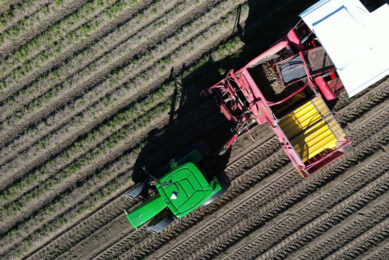Five years of practical experience with NIR technology

Dutch Agro innovation center De Marke has now been conducting research for five years into the accuracy of NIR sensors for determining contents in liquid manure. A new sampling method partly casts a different light on the results.
Agro innovation center De Marke in Hengelo (Gld.), The Netherlands, a research company of Wageningen University & Research (WUR), has been investigating since 2018 how accurately an NIR sensor can determine levels in kilograms per cubic meter of liquid manure. This is partly done in the context of the National Experimental Garden Precision Agriculture (NPPL) project. The company is supported in this by WUR researcher Herman van Schooten.
Contractor Freriks applied undiluted and water-diluted cattle manure and liquid fraction with a Vervaet self-propelled slurry injector fitted with a John Deere NIR sensor.
New sample method
To determine whether the NIR sensor correctly estimates the amount of nitrogen (N), phosphate (P2O5) and potassium (K2O) in the manure, about half a liter of manure was collected until 2022 after filling the manure tank. The amount of fertilizer that flows back from the filling hose. These half liters were mixed per spreading moment into a mixed sample that was offered to Dutch company Eurofins Agro for analysis.
Herman van Schooten averaged the measured values of the NIR sensor per exit moment. The daily averages are plotted as points in a graph for each content, with the results from the Eurofins Agro laboratory on the X-axis and the results of the measurements with the NIR sensor on the Y-axis. A dotted line indicates the position at which the daily averages (spheres) of the NIR sensor should be if it measures identical levels as the laboratory (see graphs below).
Text continues below graphs


Van Schooten: “On average, the nitrogen levels measured by the NIR sensor correspond to the results of Eurofins Agro, which we consider to be leading. For 2022, however, there was a greater spread than in 2022. This is probably because the method of sampling has changed. Since 2022, De Marke has been using a unit that is mounted in/between the filling hose. With this unit, a person takes a manual sample per filling cycle while the manure tank is being filled. This gives better, more accurate manure samples for lab analysis. We already knew this, but the sampling unit was not there until 2022.”

Zwier van der Vegte, project manager at De Marke, emphasizes once again that the company does everything it can to keep the cattle manure as homogeneous as possible. “With us, the manure in the manure cellars and the basin is mixed daily.”
Text continues below picture

Constant deviation
Although the amount of nitrogen in undiluted and diluted cattle manure and liquid fraction is determined correctly on average despite the spread by the NIR sensor, this has not been the case for phosphate and potassium for five years. “There, too, we see less spread in the graphs in 2022 thanks to the new sampling method, but the NIR sensor still overestimates the phosphate levels by an average of 30%. The levels of potassium are always underestimated by about 40%.”
Van der Vegte does not have the impression that the contractor’s NIR sensor has recently been fitted with new calibration lines for translating the measurements into levels. “At least not in response to our findings. And if that were the case, it would not be apparent from our measurements.
Incidentally, the contractor’s driver successfully uses the cattle manure calibration line for undiluted and diluted cattle manure and liquid fraction.” Van der Vegte still wishes to control the fertilizer application on the basis of phosphate. Preferably depending on the local amount of phosphate in the soil. “Until there is a sensor that can measure the amount of phosphate in the soil, whether or not in real time, that is not possible. What is technically possible is to dose the fertilizer in real time on the basis of the phosphate content in the manure. Then I want to have the amount of phosphate applied uniformly and to document the amount of nitrogen applied site-specifically. But then the driver of the self-propelled fertilizer must be able to manually increase the phosphate calibration line of the NIR sensor by 30%. Otherwise I can’t use the NIR sensor for that. I can then adjust the dose of nitrogen fertilizer to the variations in applied amounts of nitrogen from cattle manure. This helps us to make better use of the decreasing nitrogen usage space.”

Join 17,000+ subscribers
Subscribe to our newsletter to stay updated about all the need-to-know content in the agricultural sector, two times a week.



